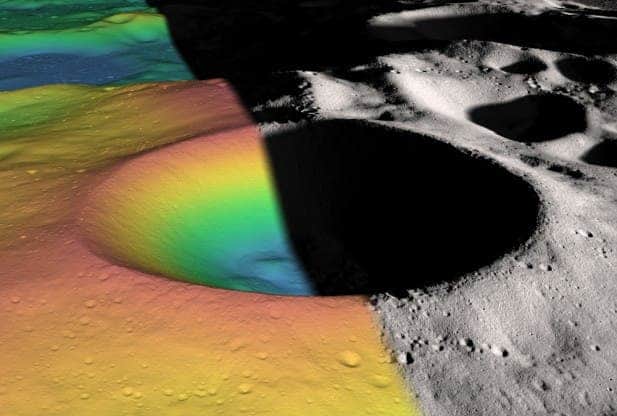
The permanently shadowed crater adjacent to the lunar south pole, called Shackleton, after the famous Antarctic explorer. Left elevation mapping, right digital photo of the crater. The structure of the crater’s interior was revealed by a digital elevation model constructed from over 5 million elevation measurements from the Lunar Orbiter Laser Altimeter. (c) NASA
Scientists at MIT, Brown University, and NASA’s Goddard Space Flight Center may have come across an incredible discovery, after data from the Lunar Reconnaissance Orbiter (LRO), a spacecraft which orbits the Moon from pole to pole, suggests water ice might be present inside a massive crater, called the Shackleton crater.
The researchers used the spacecraft’s laser altimeter to illuminate the crater’s interior with infrared laser light, measuring how reflective it was. The surface of the crater absorbed some light, and reflected back the rest to the spacecraft, based on this, the scientists calculated the difference, and mapped out the relative brightness throughout the floor and walls of Shackleton crater.
“While the distribution of brightness was not exactly what we had expected, practically every measurement related to ice and other volatile compounds on the moon is surprising, given the cosmically cold temperatures inside its polar craters,” said the scientists.
Initial estimates hold some 20% of the crater’s surface covered in ice, which is 2 miles deep and more than 12 miles wide. However, the scientists warrant that the reflectance could be a due to a combination of ice and other minerals, or something else altogether.
“The reflectance could be indicative of something else in addition to or other than water ice,” said study lead author Maria Zuber, a geophysicist at the Massachusetts Institute of Technology. For instance, the crater floor might be reflective because it could have had relatively little exposure to solar and cosmic radiation that would have darkened it.
If there is indeed ice water present on the crater’s surface, how much is it? Well, for one, the laser allowed scientists to measure only a micron-thick portion of Shackleton Crater’s uppermost layer. Scientists note that ice might be located deeper. Researchers say the measurements showed this crater’s floor is much brighter than the floor of other nearby craters, suggesting there may be ice in it, but they added that they can’t be sure. Based on current data, researchers speculate there could be as much as 100 gallons of ice inside the crater.
“The next step will be to probe deeper beneath the surface to see if there is deeper water, and we intend to do this in the GRAIL extended mission,” said Zuber.
via redorbit









